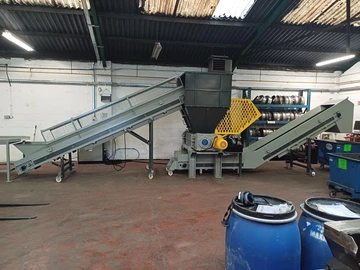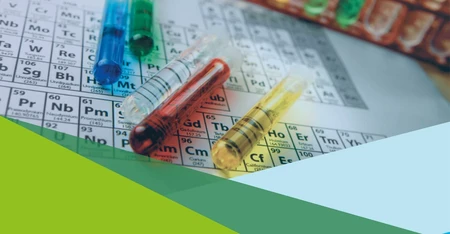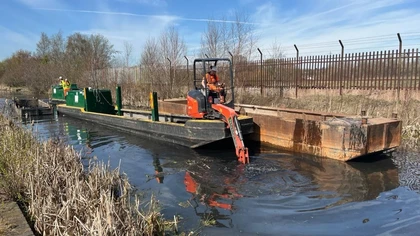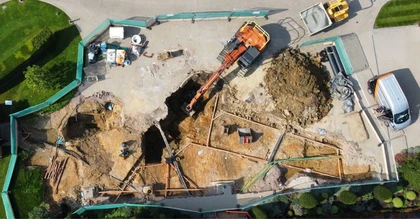SOCOTEC's environmental chemistry team provides expert testing and analysis for ammoniacal nitrogen and other nitrogen compound in our UKAS accredited laboratories.
Analysing samples of Ammoniacal Nitrogen
Soil samples are analysed by extracting the sample with potassium chloride and analysing this extract. This analyte is variously called ammoniacal nitrogen, available ammonium, and exchangeable ammonium depending upon the literature that is referenced.
As an environmental chemistry team, nitrogen compounds really are a focus for us and we like to support our clients, where possible with as much information as possible about the substances they are dealing with.
Ammonia
Free ammonia (NH3) can be present in water as dissolved ammonia or as the dissolved ammonium ion (NH4). If the pH value is less than 8.0 then the ammonia/ammonium equilibrium is such that the majority of ammonia will be present as the ammonium ion and measurable quantities of free ammonia are unlikely to be present in the sample. In the case of leachate preparation, unless the soil is sufficiently alkaline to raise the pH of the leachant to >8.0, then any ammonia present in the soil will be converted to ammonium during the leaching process.
Ammoniacal gas
In the realm of gas analysis, ammoniacal gas plays a crucial role. Derived from ammonia (NH3), a compound made of nitrogen and hydrogen, it often refers to the sum of ammonia and the ammonium ion (NH4+) concentrations in a sample. It's characterized by its colorless nature and a distinct pungent smell, making it easily identifiable in the laboratory. Different methods have been developed to determine the presence of ammonia nitrogen in natural waters, including spectrophotometric methods and ion-selective electrodes. Advanced detection systems such as optical, electrochemical, and biological enzyme detection have also been employed.
Ammoniacal nitrogen has significant environmental implications. For instance, it's a common pollutant that can be toxic, potentially leading to lower reproduction and growth rates in aquatic organisms, or even death. Thus, accurate and efficient analysis of ammoniacal gas is crucial in various industries, including environmental science and wastewater treatment.
Total Nitrogen and Kjeldahl Nitrogen
Kjeldahl nitrogen measures organic nitrogen and ammoniacal nitrogen, whereas total nitrogen will include all forms of nitrogen, including nitrate and nitrite (not measured by Kjeldahl).
Total Oxidised Nitrogen (TON)
Our total oxidised nitrogen service includes analysis of nitrate and nitrite, but please note that nitrite will tend to oxidise to nitrate in aerobic conditions.
Organic Nitrogen Compounds
These are substances such as amines, pyrroles, nitrobenzenes etc. Organic nitrogen is quantified by subtracting ammoniacal nitrogen from the Kjeldahl nitrogen value.
Analysis of Nitrogen Compounds
We express all nitrogen species as N to allow direct comparison of data. Ammoniacal Nitrogen: NH3 (ammonia) and NH4 (ammonium), total oxidised nitrogen (TON) are analysed by discrete colorimetric analysis.
Total Nitrogen:
Soils are determined by Elemental analysis, using thermal conductivity following combustion.
Waters are determined Spectrophotometrically
Elemental analysis by thermal conductivity after combustion.
Kjeldahl Nitrogen: Organic and ammoniacal nitrogen converted to ammonium sulphate by wet oxidation. The ammonium sulphate concentration can be determined spectrophotometrically or by titration.
Nitrogen Compounds in the Environment
Ammonium is by product of town gas manufacture and the coking process. Ammonia is also produced by the degradation of waste in landfills; landfill leachates contain very high levels of ammonia. Discharge of ammonium to surface water can result in significant reduction in oxygen levels as the ammonium oxidises to nitrate and nitrite. This has a significant detrimental impact on the aquatic environment.
Nitrates and ammonium are constituents of fertilizers and can be found in surface water run-off. High nitrate levels in water can lead to Blue Baby syndrome, the nitrates being converted to nitrite by the digestive system which reacts with the haemoglobin of the blood and inhibits oxygen uptake.
What is ammonia used for?
Ammonium, primarily in the form of ammoniacal nitrogen, is significantly utilized across various sectors. In the agricultural industry, it's an essential component of fertilizers, often found in conjunction with nitrates. Such fertilizers contribute to surface water runoff, leading to potential environmental impacts.
In environmental studies, it's analyzed to monitor contamination in natural waters. Recent methodologies include spectrophotometric methods, ion-selective electrodes, and advanced systems like optical and electrochemical detection.
In wastewater treatment, ammonium is a common pollutant requiring efficient removal. Processes such as membrane filtration and reverse osmosis are employed to minimize its presence, contributing to the protection of aquatic ecosystems from its toxic effects.
Lastly, in soil analysis, the determination of ammoniacal nitrogen is essential. It's extracted from soil samples with potassium chloride for further examination. The findings aid in understanding the nitrogen content and potential health of the soil.
Thus, the use of ammonium spans multiple areas, emphasizing the importance of its accurate detection and analysis.
What is the difference between free ammonia and ammoniacal nitrogen?
Free ammonia (NH3) is the unionized form of ammonia, a gaseous inorganic compound made up of nitrogen and hydrogen atoms. Free ammonia is highly soluble in water and can be toxic, particularly in environments with high temperatures and low pH levels.
Ammoniacal nitrogen is a broader term that includes the total amount of nitrogen in a sample present as both ammonia (NH3) and the ammonium ion (NH4+). Essentially, it measures the combined concentrations of free ammonia and ammonium, providing a comprehensive assessment of these nitrogenous compounds in a given sample.
Understanding this distinction is crucial for:
- Environmental Science: Monitoring ammoniacal nitrogen helps us assess water quality. High levels can indicate pollution and pose risks to aquatic life.
- Wastewater Treatment: Knowing the balance between free ammonia and ammoniacal nitrogen is vital for effective treatment processes, ensuring that effluent discharged into the environment meets regulatory standards.
By distinguishing between these forms, we can make informed decisions to protect ecosystems and human health.
Want to find out more about SOCOTEC's Environmental Science services?
You might also be interested in:

Paints and Coatings - Start to finish

SOCOTEC UK and Ireland Makes Strong Impact at ESS Expo 2025

SOCOTEC UK & Ireland Enhances Testing Capabilities with New Primary Shredder at Burton Facility

Street Works Protocol: Everything You Need to Know Before the Deadline

Characterisation of Unknowns

Preparing for 'Simpler Recycling' Legislation: Effective Waste Management Solutions






